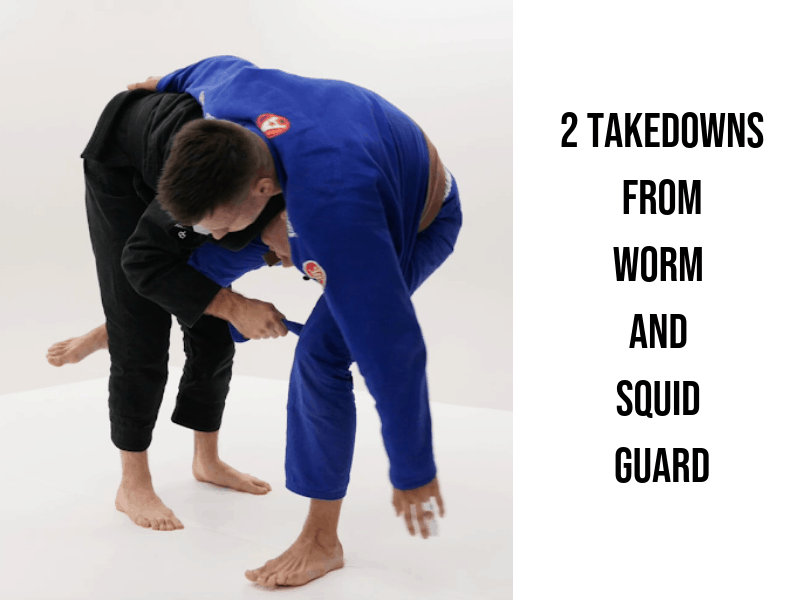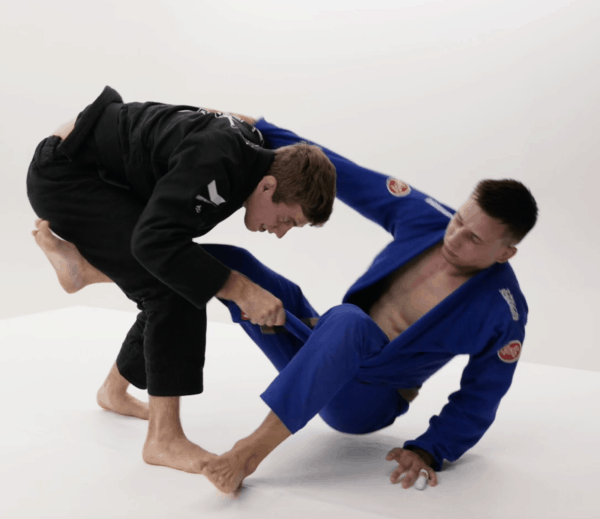
If you thought Lapel Guards like the Worm and Squid were only for young kids and IT nerds who like to do spinning sh*t…
…think again!
While spinning sh*t is cool (you know it is) mixing up your b-boy moves with good old American Wrastlin’ is one of the greatest ways to keep your opponents guessing when it comes to your guard.
Today, we’re going to show you that there’s more than one way to score two points from the guard, as we delve into two simple takedowns that will help you turn the tables on your opponent and show everyone you’ve got #everynowandthenporrada in you!
Single Leg Takedown From the Ring Worm Guard
When most people see this technique, one of the first things that come to mind is…
“Isn’t this just a single leg takedown from the Sit Up Guard? Why would I bother using the Worm Guard to set it up?
Good question.
First of all…
…shut up…
Second of all, while this may look like a single leg takedown from the Sit Up Guard, the Worm Guard variation of this faithful two pointer has a significant benefit over your precious Sit Up Guard entry…
Let me explain…



You see, one of the unique benefits of the Worm Guard is – you control the slack in the lapel trapping your leg.
What this means is, releasing a little slack when you need it will allow you to retract your foot when it counts.
So why is this different to the Sit Up Guard variation?

While this may seem like a hindrance to your movement, retracting your foot from the Worm Hole isn’t difficult and, due to the structural support of your arm behind you, won’t force you to give up much in the way of your base.


From here, you have two highly effective methods for finishing the technique…
The first can be used as a takedown or a crazy effective ninja maneuver to the back, which Keenan WILL teach you…
… just not here…
… you’ll find more information about that at the end of this article…
The second, while less ninja but by no means less effective, involves moving forward with the good ol’ single leg takedown via running the pipe, as seen in the image below…

Ok, so we’ve seen an effective takedown from the Worm, and I do apologize for redacting the info on the backtake…
… (again, there’s more info about that at the end of this article)…
… so let me make it up to you, with…
Keenan’s Grimy Double Leg From Squid Guard

Usually, in the Squid Guard, your foot would be a tad further through the hole; however, for the purpose of the double leg, you’ll need to adopt this liberated heel position to efficiently extract your foot when the time comes.






As the lapel and pant grips serve as the fundamental control needed for the grimy double leg, we should hold them as a priority and opt for the transition where our bottom leg lay between us and our opponent.

Most likely they will try to bear their weight upon you in an attempt to drive you back and flatten you on the mat.
This is where you need to act fast and immediately transition onto your elbows into a turtle-like position…
Don’t stress too much that you’ve gone from guard to turtle, as in this situation your lapel and pant leg grips are affording you the control needed to foil their advances.
Meaning…
- They can’t pass your guard
- They can’t move laterally to take your back
- You are too far under their hips for them to gain the ideal body alignment for any front headlock maneuvers
Now, all that’s left to do..



Remember how earlier I said your opponent has two options to take …
… the second being the option of stepping back and what you need to do to counter it?
Yeah, sorry I had to redact that info, too…
… but hear me out.
What you’ve learned today is just a sample from the latest project by Mr. Lapel Guard himself, Keenan Cornelius.
The remaining secrets of the techniques above, and literally HOURS MORE, are all held within Keenan’s greatest masterpiece the LAPEL ENCYCLOPEDIA.
That’s right Keenan’s world class guard system; from the fundamentals of grip hierarchy, defensive guard retentions, sweeps, subs and everything in between is now available to you!
If you’re a guard player looking to take your game to the next level, or you’re a passer who just needs to understand this web like matrix better, you won’t want to fall behind on this!
Simply enter your details below and we’ll not only subscribe you to our newsletter, but we’ll send you 3 videos from the Lapel Encyclopedia over the next 3 days – TOTALLY FREE!
So, I guess there’s only one thing left to do…
